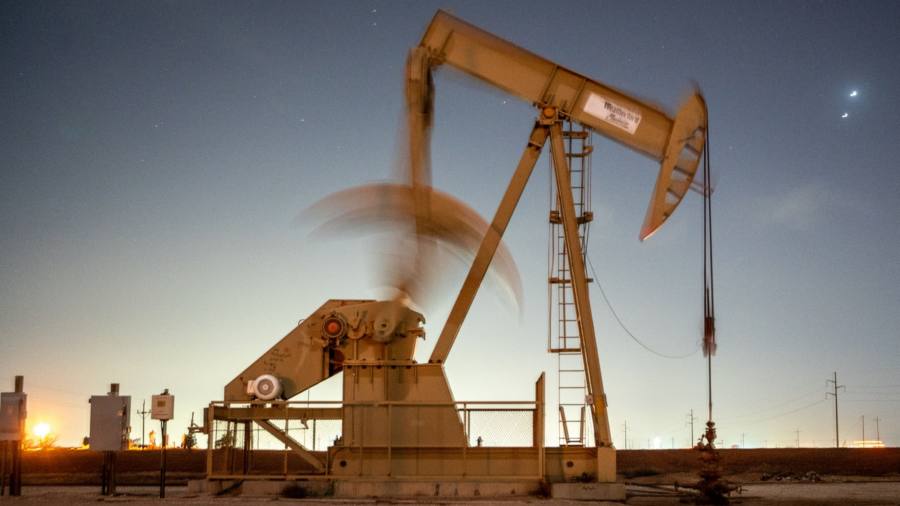Receive free Oil & Gas industry updates
We’ll send you a myFT Daily Digest email rounding up the latest Oil & Gas industry news every morning.
When a pandemic-induced drop in demand turned US oil prices negative for the first time three years ago, then president Donald Trump implored Russia and Saudi Arabia to cut production to restore order to energy markets — and spare US oil and gas producers.
Eventually, they agreed. But that period of co-operation, and that US vulnerability to other oil and gas producers, seem like distant memories now.
The soaring fuel prices and energy crisis triggered by Vladimir Putin’s invasion of Ukraine last year have upended long-established global energy trading patterns. As a result, Russia’s fossil fuel dominance in Europe has been shattered.
The US oil and gas producers so imperilled in 2020 have capitalised with bumper profits and exports. And the Biden administration has pushed ahead with sweeping climate legislation designed to break decades of western dependence on fossil fuels. “The war put energy security front and centre in a manner people thought was no longer feasible,” says
Amy Myers Jaffe, a New York University research professor and energy expert. “The US came out ahead with rising oil and gas exports and a new multibillion congressionally mandated plan to win in clean tech.”
This advantage seems likely to last. In the wake of the war, European and Asian utilities have been signing deals to keep buying American energy into the 2040s as they diversify supply. Even as the US and EU try to accelerate the transition to clean tech fuels, American fossil fuels are becoming more central to global trade and energy security.
Decades of dependence on Russian oil and gas made Europe’s response to the invasion all the more stunning. Just days after Russian troops entered Ukraine, Brussels had unveiled REPowerEU, a plan to slash imports of Russian gas by the end of 2022, replace them before 2030, reduce energy consumption, and “fast forward the green transition”.
Western countries followed up with tough sanctions against the Russian energy sector. Then, last September, mysterious explosions destroyed parts of the huge Nord Stream gas pipeline system linking Russia and Germany.
By 2021, Russia had been supplying about 150bn cubic metres of natural gas per year to Europe, or about 40 per cent of EU demand, says the International Energy Agency. Last year’s collapse of those supplies pushed gas prices to a record high above €343 per megawatt hour, sparking fears of an economic and humanitarian catastrophe on the continent, and a rush for alternatives.
But, even with Russian exports to Europe at a fraction of their prewar level, the continent’s stocks of stored natural gas remain plentiful. Prices have retreated to pre-crisis levels. Mild winter weather helped, and recession cut demand further. It now appears that “Russia has lost the energy battle” with Europe, according to Fatih Birol, executive director at the IEA.
If so, the US is collecting some of the spoils. In oil, western sanctions such as the G7’s price cap on Russia’s exports have shrunk its market share in Europe. US and Middle Eastern exports have filled the gap, while Russia has shipped discounted barrels to Asia, instead.
“Trade flows have been turned on their head with Middle East and the US exporters the key beneficiaries,” says Amrita Sen, head of research at consultancy Energy Aspects.
The war has been a boon for the US’s growing liquefied natural gas industry. Until the invasion, China and other developing countries offered US exporters of LNG the most promising markets. Now, Europe’s thirst for the fuel has added more competition for supplies.
Most US gas is sold under long-term contracts. But, as European prices spiked last year, producers such as Cheniere Energy eked out extra supplies to sell in the spot market, while traders diverted cargoes to Europe. US LNG shipments to Europe soared 140 per cent compared with 2021, to almost 2.5tn cubic feet, or about 70bn cubic metres, according to the US Energy Information Administration — equivalent to about half the volume Russia once piped to Europe.
European anxiety over energy security has also improved the longer-term outlook for US LNG exporters.
In late 2020, France’s government pushed Engie to scrap a US LNG deal amid concerns about the environmental impact of shale drilling. European utilities no longer appear so concerned. Since early 2021, they have signed up for US supplies equivalent to about 100bn cubic metres a year, says S&P Global. Engie is among the buyers.
In June, Germany’s SEFE — Securing Energy For Europe, a state-run entity — agreed with Venture Global LNG, the newest US exporter, to buy gas for 20 years. Until Moscow’s full-scale invasion of Ukraine, Germany had no need or infrastructure for LNG.
Now, Berlin has committed about $10bn to increase import capacity. Three floating terminals are in operation, another three are due to launch in coming months and more are planned — a strategic shift that will make the country a major long-term competitor with China and other Asian buyers for American LNG.
The US is the world’s biggest LNG exporter thanks to projects begun before the war.
Its lead will grow with an ExxonMobil-led plant’s start-up next year. Meanwhile, Europe’s renewed demand for US gas is translating into more contracts for future supply, too — a signal that will give investors’ the confidence to fund another wave of expansion of LNG output, along the Gulf coast.
That will anger those concerned about the climate impact of more fossil fuel projects — given Europe’s ultimate priority is to boost renewable energy supplies and accelerate decarbonisation. For now, though, Moscow’s aggression has altered geopolitical priorities, analysts point out.
“The invasion coincided with and amplified a historic shift from the primacy of decarbonisation to energy security,” says Bob McNally, a former White House adviser who now runs Rapidan Energy Group. “For US exporters, it has been a godsend.”
Read the full article here



